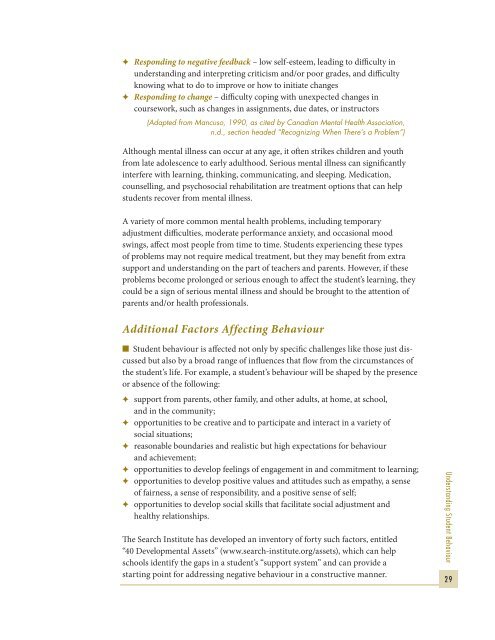Caring Safe Schools Ontario
Caring and Safe Schools in Ontario - Ministry of
Caring and Safe Schools in Ontario - Ministry of
- No tags were found...
You also want an ePaper? Increase the reach of your titles
YUMPU automatically turns print PDFs into web optimized ePapers that Google loves.
✦✦Responding to negative feedback – low self-esteem, leading to difficulty inunderstanding and interpreting criticism and/or poor grades, and difficultyknowing what to do to improve or how to initiate changes✦✦Responding to change – difficulty coping with unexpected changes incoursework, such as changes in assignments, due dates, or instructors(Adapted from Mancuso, 1990, as cited by Canadian Mental Health Association,n.d., section headed “Recognizing When There’s a Problem”)Although mental illness can occur at any age, it often strikes children and youthfrom late adolescence to early adulthood. Serious mental illness can significantlyinterfere with learning, thinking, communicating, and sleeping. Medication,counselling, and psychosocial rehabilitation are treatment options that can helpstudents recover from mental illness.A variety of more common mental health problems, including temporaryadjustment difficulties, moderate performance anxiety, and occasional moodswings, affect most people from time to time. Students experiencing these typesof problems may not require medical treatment, but they may benefit from extrasupport and understanding on the part of teachers and parents. However, if theseproblems become prolonged or serious enough to affect the student’s learning, theycould be a sign of serious mental illness and should be brought to the attention ofparents and/or health professionals.Additional Factors Affecting Behaviourn Student behaviour is affected not only by specific challenges like those just discussedbut also by a broad range of influences that flow from the circumstances ofthe student’s life. For example, a student’s behaviour will be shaped by the presenceor absence of the following:✦✦support from parents, other family, and other adults, at home, at school,and in the community;✦✦opportunities to be creative and to participate and interact in a variety ofsocial situations;✦✦reasonable boundaries and realistic but high expectations for behaviourand achievement;✦✦opportunities to develop feelings of engagement in and commitment to learning;✦✦opportunities to develop positive values and attitudes such as empathy, a senseof fairness, a sense of responsibility, and a positive sense of self;✦✦opportunities to develop social skills that facilitate social adjustment andhealthy relationships.The Search Institute has developed an inventory of forty such factors, entitled“40 Developmental Assets” (www.search-institute.org/assets), which can helpschools identify the gaps in a student’s “support system” and can provide astarting point for addressing negative behaviour in a constructive manner.Understanding Student Behaviour29
















